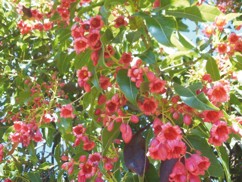| Perennial / Evergreen Trees / Brachychiton populneus |
|
|
|
|
| |
|
Plant name - Brachychiton populneus |

|
|
 |
|
 |
| Common name -
Brachychiton |
| Plant type - Evergreen |
| Vegetation type -
Perennial |
| Growth rate - Medium |
| Leaf / Flower color
- Green / White - Red |
| Other names - Brachychiton populneus
|
| |
| Description : |
Brachychiton populneus, commonly known as the Kurrajong, is a small to medium sized tree found naturally in Australia in a diversity of habitats from wetter coastal districts to semi-arid interiors of Victoria, New South Wales and Queensland. The extended trunk is a water storage device for survival in a warm dry climate. The bell-shaped flowers are variable in colour (pale to pink) while the leaves vary considerably in shape. The leaves are either simple and pointed, or may be 3 - 9 lobed. Saplings grow from a drought and fire resistant tap-rooted tuber.
Kurrajong has multiple uses. Seeds are eaten by Aboriginal people after roasting. The soft spongy wood was used for making shields, and the bark as a fibre. The leaves are also used as emergency fodder for drought-affected animal stock.
It has been introduced as an ornamental tree to south-western Australia, South Africa, Louisiana, California, Arizona and Mediterranean countries. In Western Australia it was observed to be invasive in disturbed areas.
Horticulturists have hybridised the Kurrajong with related Brachychiton species, including the Queensland bottle tree (B. rupestris) and Illawarra Flame Tree (B. acerifolius) to produce new garden ornamentals.
The specific name populneus pertains to a perceived similarity to genus Populus, the Poplars. Sometimes B. populneus is also known by the names "lacebark kurrajong" and "bottle tree" (USA). However, B.discolor is also referred to as the Lacebark Kurrajong, and Bottle Tree is a term commonly applied not only to other species of Brachychiton but to members of other genera around the world.
The kurrajong has been recorded as a host plant for the mistletoe species Dendrophthoe glabrescens.
|
| |
| Growing Instructions : |
* Combine equal parts peat moss and perlite to create sprouting mix suitable for Brachychiton tree seeds. Fill one 4-inch plastic pot with the mixture for each seed you wish to germinate. Moisten the soil to a 4-inch depth using a garden hose with an adjustable nozzle set to mist. Allow the soil to drain for 20 minutes before sowing the seeds.
* Press one seed into the center of each pot of soil. Push the seed in until the top is flush with the surface of the soil. Sprinkle a small amount of soil on top but do not completely cover it.
* Stretch plastic wrap over the pot. Poke two or three small holes in the plastic wrap to allow for evaporation and increased air flow.
* Place the pots where they will receive bright light and temperatures above 80 degrees Fahrenheit during germination. Place the pots on a propagation heat mat to maintain constantly warm temperatures for at least 15 days. Apply 1 inch of water to the seeds after seven days.
* Repot the Brachychiton tree seedlings into 2-gallon plastic pots once they reach 3 inches in height. Fill the new pots to half their capacity with a mixture of 3 parts potting soil, 1 part horticultural sand and 1 part perlite.
* Remove the Brachychiton tree seedlings from their original pots. Set them atop the soil inside the new pot and fill in around the sides with the potting soil mixture until the soil level is flush with the base of the stems. Firm gently and apply 4 inches of water.
* Place the pots in a warm greenhouse for the duration of winter. Plant them in a permanent bed when outdoor temperatures reach 70 degrees Fahrenheit. Choose a planting site with full sun and good drainage.
|
| |
|
|
|
|
|
